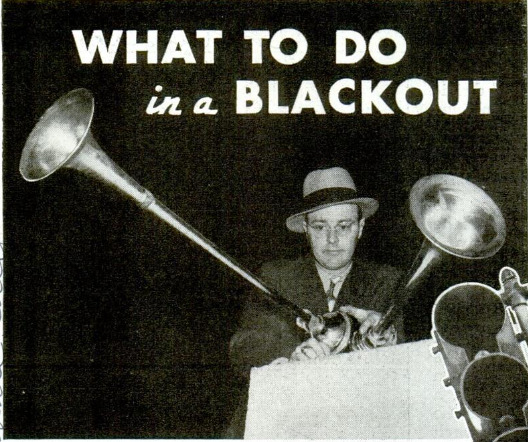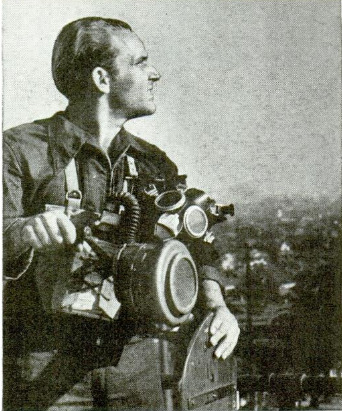CALIFORNIA was “on the yellow” - enemy airplanes had been reported by watch stations of the aircraft warning service and the yellow alert signal had been flashed to every community. Then in the interceptor headquarters in Los Angeles an Army officer snapped off the yellow light and flashed on the blue. Almost immediately, police radio stations were notifying their prowl cars: “Air-raid message, all cars. Blue light. Blackout at once.” Air horns and sirens began howling the blackout message. Section by section, street light switches were pulled. Broadcast stations went off the air. Advertising signs winked out. Householders doused their lights. Air raid wardens sprang to duty and stopped all traffic, ordering lights turned off. With few exceptions, all of southern California and most of the Pacific southwest was black. The air raid didn’t come, that time, but the test showed that Los Angeles, with its surrounding communities can hide in darkness faster than many European cities. That's because many preparations had been made ahead of time. Airplane plants were blacked out with window paint so production could continue night and day. Airports, defense factories, bridges, tunnels and power stations are under guard. Automobiles and airplanes patrolled power lines and aqueducts. Citrus ranchers whose heavily smoking smudge pots had been deplored in the past were told that their smoke blanket may help keep enemy bombers from locating their targets. Fifteen thousand auxiliary police were enrolled in Los Angeles to serve as air-raid wardens. Fire department auxiliaries were detailed as fire watchers and were trained in clearing debris, handling incendiaries, and in poison gas protection. Traffic lights were hooded from above and their normal brilliance was reduced by black paint that left only a thin cross of clear glass. Headlights of emergency cars were hooded and sprayed with dark blue paint. Air horns with their own supplies of compressed air were installed as air-raid warning systems with arrangements for operating them even if ordinary electrical and communication lines fail. Construction of air-raid shelters was begun. Civilians were moved from homes adjacent to fortified areas, and forest areas were closed as a precaution against fires. Passenger and freight trains operated with lights dimmed. At the harbor, ship traffic was halted after dark and an anti-submarine net was raised across the entrance to prevent passage from dusk to dawn. Merchant ships worked cargo at their piers in the daytime and moved to anchorages in the outer harbor over night. All these precautions with varying details have been duplicated at San Diego, San Francisco, Seattle, and the other west-coast defense areas. If you live in any area that might be visited by enemy bombers, there are a number of things that you should do at once without waiting for the emergency to occur, First, familiarize yourself with the local blackout, air raid, and all clear signals and regulations. Those vary in different communities. It is a good idea to store five gallons or more of fresh water in sterile glass containers against a possible interruption of the water supply, changing the water every few weeks. Lay in a supply of candles and fresh. flashlight cells. You might need them if your domestic electricity is cut off or fails. Next, get one room ready as a blackout, room inside of which you can use lights| after dark when a blackout has been ordered. The kitchen is-often best for this because light is needed for preparing meals. The room must be arranged so no light escapes outside. A sandwich of newspapers and blankets tacked across each window will keep all the light inside. Special shadowproof blinds will do the same if you seal their edges to the window openings. Plywood panels cut to fit the windows also prevent leaks. Window screens may be covered with black roofing paper for the same effect. If the door to your blackout room is apt to leak light outside when opened, turn out the lights when using the door. Next, if no public air-raid shelter is available nearby, decide on the safest room in the house and be prepared to remain in it when a raid is occurring. A lower room is safer than one on an upper floor, and one in the middle of the house that is protected by several thicknesses of walls is safer than an exterior room. Such a choice should provide excellent protection from fragments and flying splinters, which is about all the security that most air raid shelters afford. All fires in a house should be extinguished at the first warning. Remember, those who allow themselves to become panicky are in the greatest danger. No matter what sort of shelter you have, it is safest to remain there. If you are caught in the open, lie down. There are several ways to deal with incendiary bombs. Fill a barrel or several sacks with dry sand and store them in a dry place, with a shovel nearby. Dry sand, carefully banked around and smothering an incendiary bomb, will not put it out but will reduce its action and keep its fire from spreading. Another way to fight an incendiary is with a fine water spray such as is produced when a garden hose nozzle is| twisted to deliver a mist. Never direct a solid stream of water at an incendiary. This increases combustion so rapidly that the thing seems to explode. The fine spray, also, increases combustion, but at a slower rate, and helps the bomb to burn itself out and at the same time helps protect the material it is ying on. Have a ladder available so that you can reach roof fires. If you are driving a car when a blackout occurs, follow the rules that have been laid down in your area. Even if your headlights have been painted blue you still probably will be required to park your car, turn out the lights, and seek shelter. Park against the side of the road if you can but in all events leave a lane clear in the middle of the street so that emergency equipment can pass. If you must leave your car near the middle of the street, leave the ignition key in the lock so that it can be moved ifnecessary. Don’t seek shelter against a building where debris may fall on you. Get inside and stay away from windows. Windows that are opened are less apt to shatter from concussion. Even if the local rules permit slow driving with all lights out, don’t try it. Thousands of dollars worth of damage was done to cars and lamp posts in Los Angeles during its first blackout, when such driving was permitted, aside from a number of serious accidents. If you are walking, it is dangerous to cross streets, even with white or luminous clothes. Don't expect the driver of an emergency car who is using the tiny blue military blackout beams to see you. Such lights give him little illumination and are merely to warn you. Another thing, don't take blackout enforcement into your own hands by smashing advertising or display signs that haven’t been turned off. Sometimes an open circuit will cause a serious fire. Emergency switches should be provided that can be operated by air-raid wardens.




